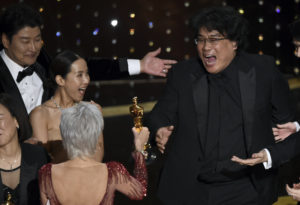‘Parasite’ Is a Class-Conscious Climate Parable
Audiences tend to view apocalyptic stories as fantasy. Bong Joon-ho's landmark film makes the case that we're already living in a dystopia. Choi Woo-sik and Park So-dam star in "Parasite" (2019). (CJ Entertainment)
Choi Woo-sik and Park So-dam star in "Parasite" (2019). (CJ Entertainment)
What follows is a conversation between Dr. Min Song and Kim Brown of The Real News Network. Read a transcript of their conversation below or watch the video at the bottom of the post.
KIM BROWN: Welcome to The Real News. I’m Kim Brown.
At the 92nd annual Academy Awards show that aired Sunday, the film Parasite became the first foreign language film ever to win the Oscar for best picture. The film simply cleaned up; picking up the best original screenplay, and the erudite director Bong Joon-Ho won the Oscar for best director. Spoiler alert: It is first and foremost about segregation by class between the elites and everyone else in South Korea. But it’s also about climate change and those who will bear the brunt of it on the front lines, a topic that makes a key twist in the movie’s plot about halfway through the film. As The Real News climate reporter alumnus Dharna Noor wrote for the publication Earther, Parasite is not only the first foreign language film to win one of the industry’s most hallowed prizes, it is also the first best picture winner to zoom in on the societal impacts of the climate crisis.
Now joining us to talk about it is Dr. Min Song who wrote a piece for the Chicago Review of Books titled, Climate Change in the Film Parasite: An Ecological Look at Bong Joon-Ho’s new film. Dr. Song is a professor in the English department at Boston College. He also directs the school’s Asian American studies program. He’s the former editor of the Journal of Asian American Studies, and he’s the author of the forthcoming book titled Climate Lyricism. Thank you for joining us, Dr. Song.
MIN SONG: Thank you for having me.
KIM BROWN: So again, if you’re watching: spoiler alert. Now that said, Dr. Song, do us a favor and summarize your piece for us and any thinking that you’ve done on the topic since because, how and why is Parasite a film about the climate crisis?
MIN SONG: Okay, so it never actually mentions climate change or global warming anywhere in the film, but it does if you’re paying attention for it, really come across very strongly. It starts really about halfway through the film. It carefully sets up the story where these very poor working class people find a way to get jobs working for this very wealthy family. Halfway through the film, the wealthy family go away on a camping vacation, and this poor family, the Kim’s, get to just take it easy and kind of celebrate what they have and they’ve just kind of camped out in the house.
Of course, this huge rain happens at this point, and this is where I think climate change really starts to figure in. Not so much saying, here’s an example of climate change as much as, here’s an effect of what happens when the weather gets really extreme. The wealthy people have to come back from their camping trip because they’re almost washed away. And for them, it’s just a minor annoyance. But for this family who have to scramble to escape, there’s this really, I think amazing dramatic scene.
MIN SONG: It’s such a dramatic moment in the film to see the difference between these very wealthy people who live on top of a hill for whom this unusually extreme weather is just an annoyance, and this working class family who loses everything and ends up in a gymnasium that’s made into a kind of temporary shelter. In that way, I think the film does just a really brilliant job of traumatizing for viewers how the effects of extreme weather is being lived right now. I don’t mean in the future, but I mean right now. All over the world in low lying areas where poor people live, they live in very similar circumstances. Extreme weather, not even like a hurricane but just a heavy downpour can be ruinous for people who live in these areas.
KIM BROWN: Clearly the climate crisis is not being felt equally, it’s not being shared equally amongst people of differing classes. In this film, Parasite, class is really integral to the plot of the film. These interconnected issues, how do you think they were conveyed by the director, Joon-Ho?
MIN SONG: I think the film does just a really great job of conveying the sense in which the wealthy people are sheltered, they’re literally living on a hill. The poor people live below, they’re always associated with the ground, the earth. A lot is made about their smell. There’s definitely a sharp class distinction being made. I think there’s two important parts to this film that we need to keep in mind when we’re talking about class. The first part is that the wealthy family are not evil characters. They aren’t going out of their way to mistreat their workers, and in fact they treat their workers as well as one could in those situations. It’s clear that they pay them very well and they take care of them. Though they boss them around. And basically, they’re expected to be there and be invisible. They also do say sort of obnoxious things about their smell later in the film.
But the people themselves aren’t notably evil characters. They’re just really normal, ordinary kind of people. And in some ways, the problem that the wealthy family have in the film is that they’re ordinary and they really want to believe that they are more than that, that they are extraordinary people. The mother is desperate to believe, for instance, that her son has artistic talent or that her daughter is going to be a really stellar student, and it’s clear throughout the film that the son probably doesn’t have a whole lot of artistic skill, and that the daughter isn’t going to be a great student. The other thing that the film does with class that’s really interesting is that in order for the poor family to get the positions that they get in this wealthy household, they have to push out another woman who’s working there as a maid.
The film becomes also a conflict between working class people. One of the challenges for the characters in the film is not so much overcoming the resistance of the wealthy people in terms of giving them or valuing their labor properly, as much as it is also about the difficulties of creating solidarity within working class people. They are fighting each other for what are really scraps or really menial jobs. And so, the film is also about the incredible difficulty of people who are in very similar socioeconomic positions, finding solidarity with one another. More often than not in the film, what’s shown is that they are in fierce competition and constantly undermining.
KIM BROWN: Dr. Song, there’s also some Native American imagery at the center of many key scenes in the movie. What did you make of that in a film mostly about South Korea? What do you think Parasite is conveying there with regards to the United States and its Indigenous population?
MIN SONG: That’s a really great question, and I’ve been mulling it since I’ve seen the film. I’ve been trying to figure out what the Native American imagery is doing. On the one hand, I think it’s extremely important to be careful about such imagery. It just gets so abused. Native American headdresses and figures get used as ornaments all the time in I think extremely troubling ways. The film may be doing that, and it’s certainly something to keep in mind when we’re watching the film and really thinking about what the imagery means. I don’t want to at all suggest that we should dismiss that possibility. My own sense of the film was that it really wanted to create that it’s meant to show something about the wealthy family, that they are oblivious to how offensive that that use of Indian headdresses and tomahawks and teepees are. That they see that as just a kind of fun affectation, or just entertainment. They are oblivious to the controversy around it.
So if that’s the point of the film, I think it’s a really extraordinary thing that it’s meant for a Korean audience first, and that a Korean audience then is being expected to understand how messed up the Native American imagery is and that they’re supposed to understand that this does not say nice things about the wealthy family, that they are people who don’t understand or insensitive to these kinds of issues. And if that’s the case, I think it’s actually quite an extraordinary move in the film in the ways in which it assumes its audience knows this stuff and is sophisticated about understanding the face of Native Americans and US racial politics.
KIM BROWN: Dr. Song, you teach classes on climate change in literature, but it’s also becoming increasingly popular as a film topic. Paul Schrader’s recent film, First Reformed, nominated for best original screenplay in 2019, it comes to mind. Talk to us about the importance of pop culture books and film in particular in conveying the urgency of the climate crisis in a way that reaches new audiences.
MIN SONG: Yeah. I think it’s obviously important. The ways in which it’s important though I think really needs to be thought carefully about. On the one hand, we do have a lot of very popular narratives in TV shows, and movies, and novels, and comic books even that show people living under extreme weather conditions where their climate has changed. But it’s often in places far away like on another planet or in some future place, like a apocalyptic narrative. Sometimes it’s caused by things like a meteorite or the sun inexplicably expanding and heating up. There’s all sorts of weird reasons why the climate changes in these films, and they’re always seen as kind of fantastical moments. So we are quite comfortable actually with depictions of our planet or our human inhabited planet becoming uninhabitable and then people struggling to survive on that planet.
That’s a actually very, very familiar story. But there’s always, what makes it entertainment in some way is it’s so far away from us and so distance. So what’s interesting about a newer wave of stories of films and movies and so on, or films and novels and so on, is the ways in which the setting is not far away but it’s actually very close and it’s set in the present, not in the far future. Those kinds of things are happening all around a very familiar landscape, which looks a lot like our own. I think that’s actually a really important move for narratives about climate change to make to show how people are struggling to survive in a world that’s already changing around them, where extreme weather events are becoming more common, where there are droughts and fires, and that fiction in some ways is already reflecting a landscape that is our landscape.
Those are the kinds of narratives I think we need more of, and we’re starting to get them. In some ways what’s happened I think though, is that narratives have kind of lagged behind what’s actually happening in the world around us. It’s been true for a long time. At least in my memory I think that one extreme weather event that really sticks out to me is Hurricane Katrina. I remember very vividly watching it on TV and thinking, wow, this is like a movie. But movies themselves haven’t really been able to show how those events are connected to climate change and how people are living that kind of reality until more recently. I think that’s maybe a reflection of that lag that’s happening in literature.
KIM BROWN: We’ve been speaking with Dr. Min Song, who is a professor in the English department at Boston College. He also directs the school’s Asian American studies program. He’s working on a new book titled Climate Lyricism. Dr. Song, we do appreciate your time today. Thank you so much.
MIN SONG: Thank you.
KIM BROWN: And thank you for watching The Real News.
Your support is crucial…
With an uncertain future and a new administration casting doubt on press freedoms, the danger is clear: The truth is at risk.
Now is the time to give. Your tax-deductible support allows us to dig deeper, delivering fearless investigative reporting and analysis that exposes what’s really happening — without compromise.
Stand with our courageous journalists. Donate today to protect a free press, uphold democracy and unearth untold stories.






You need to be a supporter to comment.
There are currently no responses to this article.
Be the first to respond.